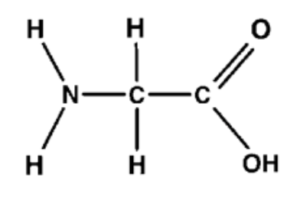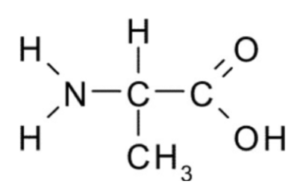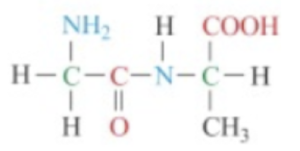Amino Acids (GCSE Chemistry)
Amino Acids
Amino Acids
- Amino acids are naturally occurring monomers. Amino acids are naturally occurring compounds. They react in condensation polymerisation reactions as monomers to form longer chains known as polypeptides. Polypeptides join together to form larger structures known as proteins.
- There are 2 functional groups in an amino acid. The two functional groups in an amino acid are an amino group (NH2) and a carboxyl group (COOH). The simplest amino acid is glycine.
- Proteins have the same amide linkage as nylon. Like nylon, proteins have an amide linkage. However, nylon is made from only two monomers whereas protein is made from several monomers which are all amino acids.
Examples of Amino Acid Polymerisation
- Amino acids form proteins. As mentioned previously, amino acids are monomers, which are used to form proteins (polymers). The amino group of one monomer reacts with the carboxyl group of the other monomer.
- Proteins are used in the human body. These proteins are used in the human body as enzymes, antibodies and to transport oxygen.
- Condensation polymerisation forms water molecules. During condensation polymerisation, water molecules are formed. The amino group loses a hydrogen and the carboxyl group loses an OH group, forming H2O.
- Glycine is a simple amino acid. One of the simplest amino acids is glycine. This polymerises to produce the polypeptide (-HNCH2COO-)n and n H2O.
Worked example: Draw the repeating unit formed when the amino acid glycine reacts with alanine.
The structure of glycine is given here:

The structure of alanine is:

Answer:
1.The -COOH of one molecule will react with the -NH2 part of the other molecule. Draw the molecules with these parts next to each other

2. Identify where bonds break. Check where the C-OH bond breaks and where the N-H bond breaks to form water.
3. The C forms a bond with the N.
4. Break the C-OH and N-H bonds. These are at the ends of each molecule respectively.
5. Add the square brackets. Also add the “n” on the bottom right hand side.
6. Add 2nH2O.

Amino acids are the building blocks of proteins. They are composed of a central carbon atom (the alpha carbon), a hydrogen atom, an amino group (NH2), a carboxyl group (COOH), and a unique side chain (R group) attached to the alpha carbon.
There are 20 different types of amino acids that are commonly found in proteins.
Amino acids play a crucial role in the body as the building blocks of proteins, which perform a variety of functions, such as building and repairing tissues, producing hormones and enzymes, transporting molecules throughout the body, and helping to regulate metabolism.
Amino acids are classified based on the properties of their unique side chain (R group). There are polar amino acids, non-polar amino acids, acidic amino acids, and basic amino acids.
Amino acids are synthesized in the body through a process called protein synthesis. During protein synthesis, specific sequences of amino acids are joined together by peptide bonds to form a protein molecule.
Yes, amino acids can be used as a source of energy when glucose levels are low or when the body needs extra energy. However, this should not be the primary source of energy for the body, as it can lead to a breakdown of muscle tissue.
If the body lacks a certain type of amino acid, it can cause a deficiency in protein synthesis, which can result in a variety of health problems. Some amino acids are essential, meaning that the body cannot synthesize them and they must be obtained from the diet.
Amino acids play a role in the flavor of food by contributing to the taste, aroma, and overall quality of the food. Some amino acids, such as glutamate, have a savory flavor that is referred to as umami.
Amino acids participate in chemical reactions as both reactants and products. For example, they can be broken down in the body through a series of reactions to produce energy or they can be synthesized through reactions to form new protein molecules.
In the digestive process, amino acids are broken down from protein molecules into their individual components. The amino acids are then absorbed into the bloodstream and transported to cells throughout the body, where they can be used for protein synthesis and other functions.






Still got a question? Leave a comment
Leave a comment